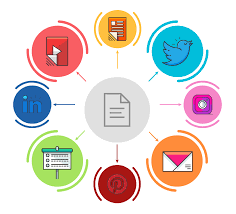ntroduction
Creating high-quality content requires significant time and effort. However, many content creators overlook an essential strategy that can amplify their work’s reach and impact—content repurposing. Instead of constantly generating new material, repurposing allows you to reuse and transform existing content into different formats, ensuring maximum visibility and engagement across multiple platforms.
In this article, we’ll explore why repurposing content is a game-changer, how to do it effectively, and the best strategies to optimize your content marketing efforts.
The Benefits of Content Repurposing
1. Maximizes Content Lifespan
Creating content from scratch takes time, and trends change quickly. Repurposing allows you to breathe new life into old content, keeping it relevant and ensuring it continues to provide value long after its initial publication.
2. Increases Audience Reach
Not all users consume content in the same way. While some prefer reading blog posts, others engage more with videos, infographics, or podcasts. By repurposing your content into multiple formats, you can cater to a diverse audience across different platforms.
3. Boosts SEO and Visibility
Repurposing content helps improve search engine rankings by increasing keyword coverage, earning backlinks, and driving more traffic to your site. Google favors fresh, updated content, making repurposed posts valuable for ongoing SEO success.
4. Enhances Brand Consistency
Reinforcing key messages across various platforms builds brand authority and recognition. By repackaging content into different formats, you ensure your audience encounters your message multiple times in different ways, strengthening brand recall.
5. Saves Time and Resources
Rather than spending hours generating new ideas, repurposing allows you to work smarter, not harder. You can extract value from existing material and allocate resources to other critical marketing initiatives.
Effective Content Repurposing Strategies
1. Turn Blog Posts into Social Media Snippets
Your well-researched blog posts are excellent sources of social media content. Extract key takeaways, statistics, or compelling quotes to create engaging social media updates.
Share bite-sized insights as LinkedIn posts.
Convert key points into Twitter threads.
Design eye-catching Instagram carousel posts with blog highlights.
Pin summarized content as visually appealing infographics on Pinterest.
2. Convert Blog Content into Videos
Video content is highly engaging and widely preferred by social media users. Transform your written content into short videos:
Create animated explainer videos highlighting the core ideas.
Film a video of yourself summarizing the blog post.
Use presentation tools to create a slideshow-based video with voice-over narration.
Convert blog content into Instagram Reels, YouTube Shorts, or TikTok videos.
3. Transform Webinars into Multiple Content Pieces
If you host webinars, don’t let them sit unused after the event. Repurpose them into various formats:
Upload full webinar recordings to YouTube.
Extract key moments into short clips for social media.
Transcribe the webinar into a blog post or LinkedIn article.
Convert key insights into a visually engaging infographic.
Use slides as standalone posts on LinkedIn and Instagram.
4. Repurpose Podcasts into Written Content
Podcasts are a rich source of evergreen content. To maximize their reach:
Transcribe podcast episodes and convert them into blog posts.
Extract compelling quotes for social media graphics.
Create a Twitter thread summarizing key points.
Compile multiple podcast episodes on a related topic into an eBook or guide.
5. Compile Blog Posts into an eBook or Whitepaper
If you have a series of blog posts covering a specific topic, compile them into an eBook or in-depth whitepaper. Offer this as a downloadable lead magnet to grow your email list and establish thought leadership.
6. Create Infographics from Data-Driven Content
Visual content performs well on social media and is highly shareable. If your blog post contains valuable statistics, case studies, or research, repurpose them into infographics:
Design an infographic summarizing key points.
Convert research findings into digestible charts and graphs.
Share snippets of data as social media posts.
7. Update and Refresh Older Content
Rather than creating new content from scratch, revisit older posts that performed well and update them with fresh insights.
Add new case studies, statistics, or expert quotes.
Improve outdated visuals, screenshots, and examples.
Republish updated content with a new date and promote it as “Updated for [Year].”
8. Turn Case Studies into Testimonials and Social Proof
If you’ve written case studies highlighting client success stories, extract key findings and repurpose them into social proof.
Use short snippets as testimonials on your website.
Convert client quotes into visually appealing graphics.
Share case study highlights as LinkedIn posts or Instagram carousels.
9. Repurpose Content for Email Marketing
Emails are a powerful marketing tool, and repurposing existing content ensures a steady flow of valuable material:
Summarize a blog post into a short, informative email.
Use webinar takeaways to create a compelling newsletter.
Repurpose social media content into an email series.
Best Tools for Content Repurposing
To streamline the repurposing process, consider using these tools:
Canva – Ideal for designing infographics, social media graphics, and presentations.
Lumen5 – Converts blog posts into engaging video summaries.
Descript – Transcribes podcasts and videos for easy content adaptation.
Rev.com – Provides accurate transcriptions for video and audio content.
Grammarly & Hemingway Editor – Helps refine and repurpose written content.
Anchor by Spotify – Distributes podcast episodes across multiple platforms.
Conclusion
Repurposing content is a strategic way to maximize the impact of your work, ensuring your message reaches a broader audience with minimal extra effort. Instead of constantly creating new material, leverage what you’ve already built and adapt it for different platforms, formats, and audiences.
By implementing these repurposing strategies, you’ll not only save time and resources but also strengthen your brand presence and improve engagement across multiple channels. Start by evaluating your existing content, identify high-performing pieces, and experiment with repurposing to see what works best for your audience.
